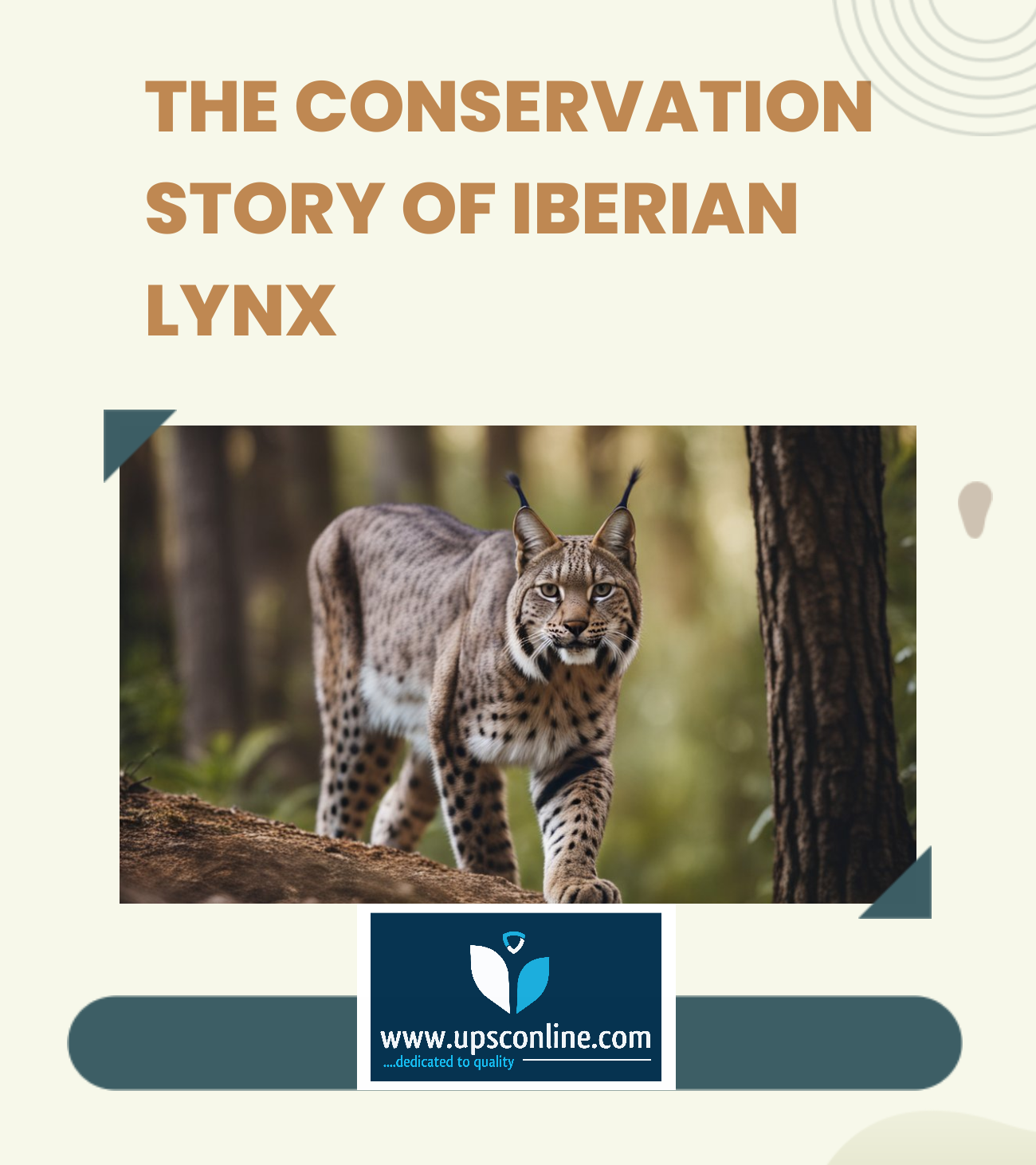The Iberian lynx is heavily spotted and weighs about half as much as the Eurasian species, with long legs and a very short tail with a black tip. Its coat is tawny with dark spots and it bears a characteristic “beard” around its face and prominent black ear tufts. It weighs around 10 to 13 kg .
Mating season runs from December to February. One to four, usually 2-3, kittens are born after a gestation period of 60-70 days. Females choose small cavities (rock caves, branch piles, dense bushes, hollow trees, etc.) as breeding dens.
Female lynxes generally give birth between March and April. The average litter size is 3, with rarely more than 2 young surviving weaning. Kittens leave the den between 8 and 23 months. Very high rates of mortality during dispersal have been detected.
The Iberian lynx mostly depends on wild rabbits to feed, but it will also eat ducks, young deer and partridges, if rabbit densities are low. While an adult lynx needs about one rabbit a day, a mother raising her young needs to catch about 3.
The Iberian lynx is a poorly known species. Little effort has been devoted to understand its biology, ecology and behaviour, perhaps due to the species scarcity and limited distribution.
These cats prefer areas of native Mediterranean woodlands with native oaks and abundant undergrowth. Iberian lynx require variable terrain below 1300 m, containing a mosaic of closed Mediterranean scrubland interspersed with open patches of grassland, often with marsh ecotones.
More than 90% of daytime rest sites are in thick heather scrub. They move along the edges of meadows and more open grassland areas, especially around dusk and dawn, to hunt their main prey species, the European rabbit. 75-93% of their diet in Donana National Park is the European rabbit.
Iberian Lynx show a great deal of seasonal and individual variation in activity levels. In summer they are nocturnal and crepuscular but in winter they are active during the daylight hours. Their overall activity patterns are closely synchronized with that of the rabbits.
Donana National Park is relatively flat (0 to 50 m above sea level) & has a Mediterranean sub-humid climate. This particular ecoregion is influenced by the Atlantic Ocean and has marked seasonality.
Like most felids, Iberian lynx are solitary animals that exhibit a metapopulation demographic structure. They depend on dispersal between populations to avoid inbreeding and thus, require movement corridors between areas of suitable habitat.
Corridors allow individuals to search for habitats outside of their of natal territory (Pedro Sarmento, et al., 2008). Under typical population densities (0.08 adults/km^2), Iberian lynx are polygynous.
In the most prey rich habitats of northern Donana National Park, the population density is much higher ( 0.8 adults/km^2). This population is close to its carrying capacity, and the total number of suitable territories is low, thus increasing intrasexual competition.
As a result, males are forced to have smaller territories that are more easily defended against rival males. Under these unique circumstances, males focus their efforts on defending exclusive access to a single female, resulting in monogamy.
Breeding season in Iberian lynx occurs from January to July and is the only time males and females interact. Breeding territories of adult males typically overlap with those of several females.
Mating season runs from December to February. One to four, usually 2-3, kittens are born after a gestation period of 60-70 days. Females choose small cavities (rock caves, branch piles, dense bushes, hollow trees, etc.) as breeding dens.
Iberian lynx kittens are born semi-altricial. As a result, they have poor thermoregulatory control and are vulnerable to predation. By giving birth in a small space (e.g., tree hollow), adult females keep their kittens grouped tightly together, which protects from heat loss and predators.
Rabbits form the main prey of the Iberian lynx. Epidemics, such as myxomatosis and the haemorrhagic disease, have affected rabbit populations over the years, which has in turn affected the Iberian lynx population. The construction of high speed roads and highways, splitting up the Lynx habitat, is another of the main threats for this wild cat.
Infrastructures like roads, dams, railways and other human activities contribute to the loss and fragmentation of the Iberian lynx distribution area, creating barriers between the different populations.
The recovery of the Iberian Lynx unparalleled among felines in an age of extinction in which species are vanishing at a rate not seen in 10 million years due to climate change, pollution & habitat loss.
The International Union for Conservation of Nature, now categorised the Iberian Lynx from the ‘red list’ representing the endangered species to the “vulnerable” one.
It is a smallest among all the lynx. Till 2001, there were only 62 Iberian Lynx in across the Mediterranean forests. It grew to 648 in 2022. Recently it marked the figures of more than 2000. There was also a 23 per cent increase in the number of females.
LIFE Lynx-Connect project, which led the conservation action for the Iberian lynx called it “the greatest recovery of a cat species ever achieved through conservation”
Other stakeholders were landowners, farmers, hunters, NGOs,scientific institutions, private companies & the European Union which provided financial and logistical support.
Conservation project focussed mostly on increasing the abundance of its prey, a species of wild rabbit which is also endangered, programmes to free hundreds of captive lynxes and restoring scrublands and forests. The translocation project and ex-situ breeding programmes lead to increase in its genetic diversity.
While IUCN opined that, the risk to the achieved figures possible from, diseases from domestic cats and among the European rabbit population it feeds on as well as poaching and road kill.
In Europe though, the lynx has been regarded as one of the three major predators of the continent along with the gray wolf and the brown bear. Indeed, the world’s second-smallest continent is home to two of the world’s four types of lynx: The larger Eurasian lynx, which is also found in Ladakh, and the smaller Iberian lynx found in the Iberian peninsula (Spain and Portugal). “The Eurasian lynx is one of Europe’s largest predators.
According to WWF Spain, a number of reasons were responsible for the cat’s decline. The main cause though was the decline in food supply. Wild rabbits, the lynx’s main food source, have sharply declined. WWF Spain attributes the decline in the wild rabbit population of Iberia to various diseases.
A paper published over a decade ago agrees. “Historically, wild rabbits have sharply declined in the Iberian Peninsula, mainly as a consequence of habitat loss and the arrival of viral diseases”.
The lynx is being introduced into Murcia.
The animal’s low population has left it with an impoverished genetic pool.Their shrinking numbers and isolation undermine genetic diversity which leads to health and breeding problems. Small population equals inbreeding.
Among several threats that the Iberian lynx faces, infectious and parasitic diseases have underlined effects on the health of their newly reintroduced populations, being essential to identify the primary sources of these agents and assess populations health status.
To achieve this, 79 fresh faecal samples from Iberian lynx and sympatric mesocarnivores were collected in the reintroduction area of Extremadura, Spain. Parasite diversity and prevalence were higher in the Iberian lynx (43.8%) compared with the others mesocarnivores under study (e.g., the red fox Vulpes vulpes & the Egyptian mongoose Herpestes ichneumon). Ancylostomatidae & Toxocara cati were the most prevalent (15.6%) parasites.
As an apex predator, the restoration of this feline in areas of historical presence has had a negative impact on sympatric mesocarnivores densities (e.g., the red fox Vulpes vulpes, the Egyptian mongoose Herpestes ichneumon, and the common genet Genetta genetta), given the Iberian lynx’s aggressive behaviour towards other carnivores and well-established territories .
This reintroduced population played an important role as predator control, having drastically reduced mesocarnivores abundances since the beginning of the reintroduction program.
In 2002, a recovery program of captive breeding was initiated. Following the program’s implementation, the number of cubs soon exceeded the facilities’ capacity, and five more centers were opened to house the animals, including the first in Portugal in 2014.
The second aim of the project is working in the field, restoring habitat and increasing rabbit numbers with a view towards reintroduction. A specialist in both prey and habitat, the cat’s survival is intimately tied to the survival of their main prey species: the rabbit.
The first lynx from the captive breeding project were reintroduced into a new area in Andalusia in 2009. Officials release captive-bred lynx in areas of appropriate habitat, rabbit abundance, and acceptance by the local human population. By 2019, the population in the wild was estimated to be 400 cats. In 2015 the Iberian lynx was officially downgraded from Critically Endangered to Endangered.
The genome of the Iberian lynx was one of the first to be sequenced (WGS) for a critically endangered species (Theissinger et al., 2023). Whole-genome resequencing studies uncovered that the species had a history of serial population declines, as evidenced by its low genomic diversity (Abascal et al., 2016).
In the subsequent studies focusing on functional genetic variation across various lynx populations, a catalog of deleterious mutations associated with decreased fitness was identified (Lucena-Perez et al., 2021; Kleinman-Ruiz et al., 2022).
Mortality rates are very high during the dispersal phase. In the Doñana area only 12 out of 35 monitored animals survived and established themselves in a new home range.
Adult lynx often kill other carnivore species of smaller size they found within their home ranges, including dog, domestic cat, red fox (Vulpes vulpes), common genet (Genetta genetta), Egyptian mongoose (Herpestes ichneumon), and otter (Lutra lutra).
The population of lynx in the Iberian Peninsula is not yet self-sustaining, nor is it out of danger. We must strengthen the links between existing populations and work towards the creation of new populations.
Before starting the captive breeding programme, a second mortality peak was observed in wild cubs around three months old. The ex-situ conservation programme observed in the firsts litters in captivity that at that age cubs develop an extreme aggressive behaviour when playing with their siblings, and that although mothers play a decisive role separating their cubs, some plays can be lethal. In captivity mothers are always close to their cubs, while this situation may be different in the wild.
It is very likely that the mother’s absence while hunting favours lethal sibling fights during excessively aggressive hunting-training plays. There are some cases of cubs in their aggressive age found with signs of fighting, such as Cromo, which was incorporated into the captivity breeding programme.



0 Comments